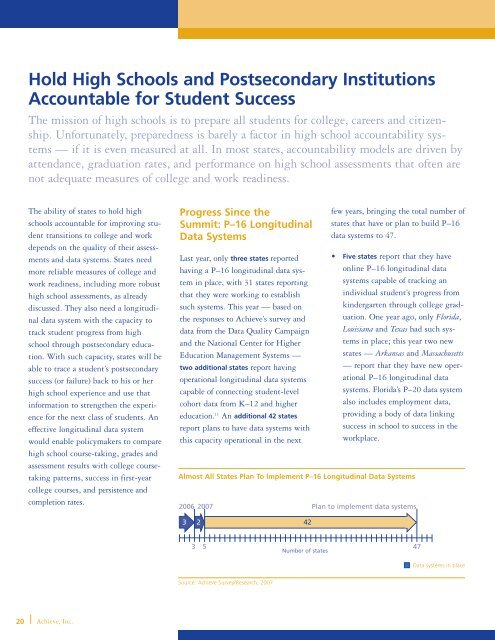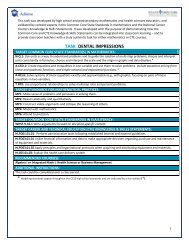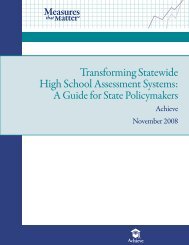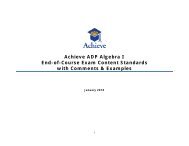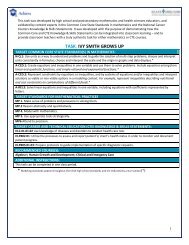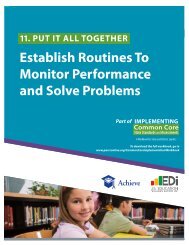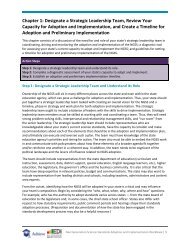Closing the Expectations Gap 2007 - Achieve
Closing the Expectations Gap 2007 - Achieve
Closing the Expectations Gap 2007 - Achieve
Create successful ePaper yourself
Turn your PDF publications into a flip-book with our unique Google optimized e-Paper software.
Hold High Schools and Postsecondary InstitutionsAccountable for Student SuccessThe mission of high schools is to prepare all students for college, careers and citizenship.Unfortunately, preparedness is barely a factor in high school accountability systems— if it is even measured at all. In most states, accountability models are driven byattendance, graduation rates, and performance on high school assessments that often arenot adequate measures of college and work readiness.The ability of states to hold highschools accountable for improving studenttransitions to college and workdepends on <strong>the</strong> quality of <strong>the</strong>ir assessmentsand data systems. States needmore reliable measures of college andwork readiness, including more robusthigh school assessments, as alreadydiscussed. They also need a longitudinaldata system with <strong>the</strong> capacity totrack student progress from highschool through postsecondary education.With such capacity, states will beable to trace a student’s postsecondarysuccess (or failure) back to his or herhigh school experience and use thatinformation to streng<strong>the</strong>n <strong>the</strong> experiencefor <strong>the</strong> next class of students. Aneffective longitudinal data systemwould enable policymakers to comparehigh school course-taking, grades andassessment results with college coursetakingpatterns, success in first-yearcollege courses, and persistence andcompletion rates.Progress Since <strong>the</strong>Summit: P–16 LongitudinalData SystemsLast year, only three states reportedhaving a P–16 longitudinal data systemin place, with 31 states reportingthat <strong>the</strong>y were working to establishsuch systems. This year — based on<strong>the</strong> responses to <strong>Achieve</strong>’s survey anddata from <strong>the</strong> Data Quality Campaignand <strong>the</strong> National Center for HigherEducation Management Systems —two additional states report havingoperational longitudinal data systemscapable of connecting student-levelcohort data from K–12 and highereducation. 11 An additional 42 statesreport plans to have data systems withthis capacity operational in <strong>the</strong> nextfew years, bringing <strong>the</strong> total number ofstates that have or plan to build P–16data systems to 47.• Five states report that <strong>the</strong>y haveonline P–16 longitudinal datasystems capable of tracking anindividual student’s progress fromkindergarten through college graduation.One year ago, only Florida,Louisiana and Texas had such systemsin place; this year two newstates — Arkansas and Massachusetts— report that <strong>the</strong>y have new operationalP–16 longitudinal datasystems. Florida’s P–20 data systemalso includes employment data,providing a body of data linkingsuccess in school to success in <strong>the</strong>workplace.Almost All States Plan To Implement P–16 Longitudinal Data Systems2006 <strong>2007</strong> Plan to implement data systems3 2423 5Number of states47Data systems in placeSource: <strong>Achieve</strong> Survey/Research, <strong>2007</strong>20<strong>Achieve</strong>, Inc.


